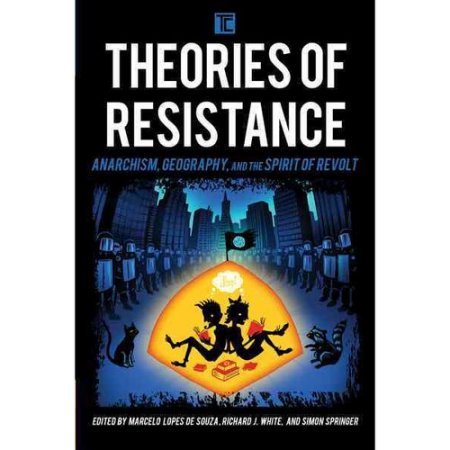Simon Springer is a prolific writer on anarchism and geography. The following is an excerpt from his forward to Historical Geographies of Anarchism, ed. F. Ferretti, F. Toro, G. Barrera, and A. Ince, in which he discusses anarchy, “the geometry of life itself,” and anarchism conceived as a political philosophy. Inspiring words in troubled times.
Anarchy is Forever: The Infinite and Eternal Moment of Struggle
Anarchy is indicative of a world free from servitude and the intrusions of governance, where there are no hierarchical institutions or mechanisms of control. It reveals a world of free association and constant change, a deep interdependence between everything that exists and the perpetual evolution of the unfolding interactions of being. In the midst of this immanence, domination represents a disruption, where in the grand scheme of things it is quickly corrected by the prevailing order of existence.
Anarchy can accordingly be considered at once the infinite and unfathomable vibrations of the universe and the geometry of life itself. It is the energy that flows through our natural world, a beautiful fractal that can never actually be broken, only temporarily interrupted.
Any suggestion that anarchy is chaos consequently signals a profound lack of understanding and serves not as truth, but as the manifestation of an anxiety born from the parochial hubris of the human mind as it attempts to restructure what actually exists in accordance with what it problematically thinks should be. Anarchy is only mayhem through the distorted lens of a fool’s sense of order.
In contrast to anarchy, anarchism is a political philosophy and practice that attempts to correct the strange intermission of the present moment, where the rhythm and flow of symbiosis has been disrupted by extraordinary mass violence. The state, capitalism, religion, sexism, racism, ableism, childism, and speciesism are all representative of the archy, or systems of domination, that form the nebula of this interference, clouding our vision through the myopia of gradation and supremacy.
It is precisely these facets of rule that are the target of anarchists. In attempting to realize the end of such cruelty, anarchists recognize that there is no primacy to the ordering of life, only the harmony of oneness. We are connected to existence as equals, with none taking precedence over another. On a larger temporal timescale it is guaranteed that the system will correct itself, whereby consonance will be restored and all existent chains of command severed.
Greed, extractivism, and the accumulation of capital will push humanity to extinction and the entire order of our planet will reset itself, shattering the false dichotomies and hierarchies that humans have fabricated. Yet for anarchists this is not the desired outcome. The pursuit of anarchism is an attempt to restore balance to the world before our collective demise becomes assured. It is a reaction to the nihilism of avarice, premised on the very radical idea that humans should continue to be woven into the fabric of the great unraveling enigma that is the universe.
Through the institution of the state and the spread of capitalism we have collectively wrestled with the natural world, imposing hierarchies and modes of domination upon the structure of our planetary existence that simply don’t make sense. They are the reflections of human arrogance that have taken us through the looking glass into a dystopian reality of profound malevolence.
We can take some measure of solace in the idea that the state and capital are facile and fugitive attempts at organization that will undoubtedly come undone, but any politics of resignation is fundamentally a practice of necromancy. These are institutions that signify the celebration of our demise and any communion with them is the fulfillment of a death wish. If we do nothing and simply wait for the eternal recurrence to arrive (Nietzsche), our shared misery as we plunge headlong towards oblivion is virtually assured.
Anarchism requires more of us. An anarchist politics insists that apathy give way to empathy. It demands the impossible, summoning us to take action in recreating the world through the realignment of our geographies towards the possibility of a tomorrow that at present cannot be assured.
The primary mode of restitution is prefiguration, a process of living life today, in this very moment, in this exact space, in a way that is befitting of the future we seek to establish. Our future is consequently to be found in the past, in the primordial anarchy that is ancient beyond memory, record, or tradition, and the living anarchism that was documented in historical struggles…
Just as anarchy was the stuff of there and then, anarchism attempts to realize a here and now. Yet this too is indicative of a false separation of space and time, demonstrating the ways that language all too often fails us. There is here, and then is now. Anything else is illusion, veiled in the ignorance of separation. The cosmology of space-time folds into itself, and the eternal now-infinite-here is but a matter of fact, the very basis of existence.
So if anarchy is the filament of our past, then anarchism is the incandescence of our present. Each plays a role in illuminating our future with the passionate radiance of connection. If we are to remain a part of the chronicle of life in its beautiful mercurial narration, we need to let the stories-so-far of anarchism guide us into a future that embraces our past as the space of anarchy.
It is the embrace of this infinite and eternal moment of struggle that sees us emerge from our chrysalis to spread our wings. It gives purpose to the work of transforming the world as we glide along a cyclical line of flight towards the reawakening of harmony. Anarchism is an uroboric geography. It is the realization of the macrocosm in the microcosm, the momentary in the infinite, the universe in a speck of dust.
Through explorations of the past, the musings offered in the pages of this book promote a vision of the horizon, enabling us to realize that anarchist geographies are the fulfillment of a world that we have the active ability to create, an ontology that yearns to be created. They envision an earth beyond militarism, beyond cruelty, beyond violence, and beyond hate, in short, a world that we would actually want to live in. They remind us that while anarchism may be fleeting, anarchy is forever.
Simon Springer


































